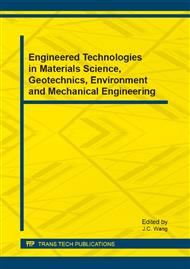p.33
p.38
p.42
p.46
p.51
p.55
p.59
p.63
p.67
Acoustic Emission Monitoring for Delaminated Composites under Bending Damage Failure Condition
Abstract:
Acoustic emission (AE) was used to monitor the three point bending test of composites with a single delamination defect. The mechanical response behavior, damage and failure characteristics, and the corresponding AE characteristics of the composites have been investigated. The results show that the location of the delamination defect has little effect on the mechanical properties of the composites, whereas the damage failure mode is significantly different. The shallow delamination defect will lead to the early fracture of high-stress fibers and a large area of delamination propagation. As the depth of the delamination increases, the acoustic emission events decrease significantly, and the AE source location is focused on the fracture site and its adjacent areas. The AE count rate, amplitude distribution, relative energy, and source location signals are connected with the bending damage and failure of the composites.
Info:
Periodical:
Pages:
51-54
Citation:
Online since:
February 2013
Authors:
Keywords:
Price:
Сopyright:
© 2013 Trans Tech Publications Ltd. All Rights Reserved
Share:
Citation:


